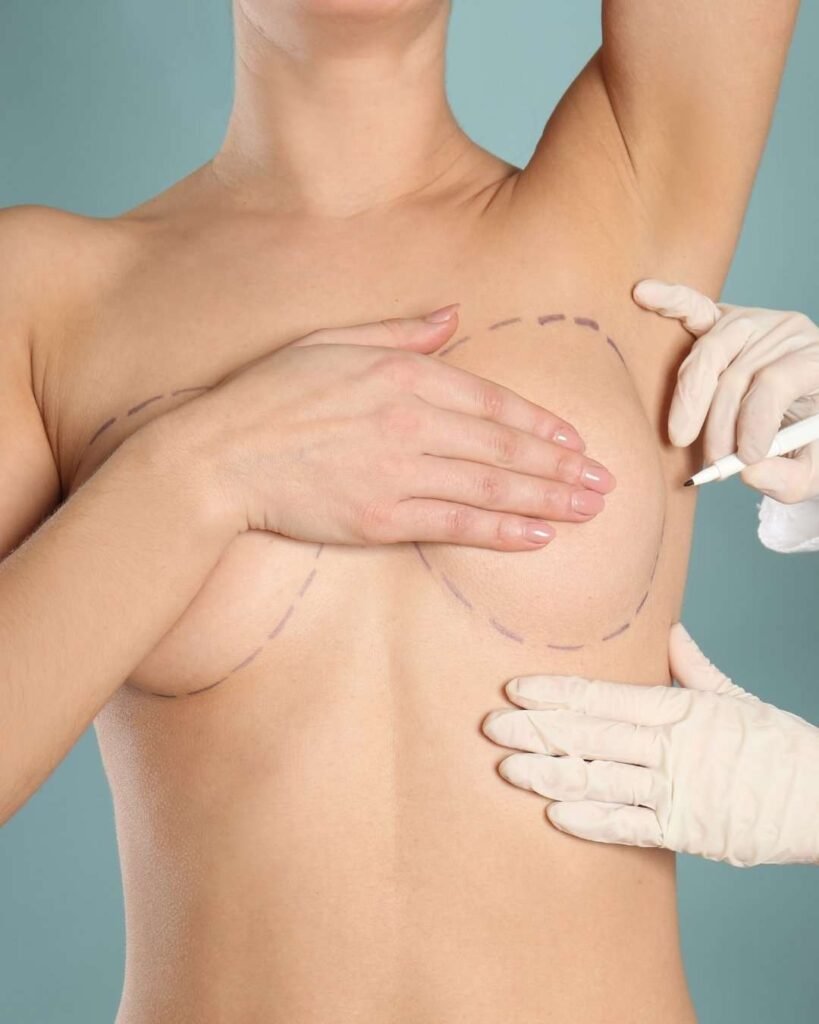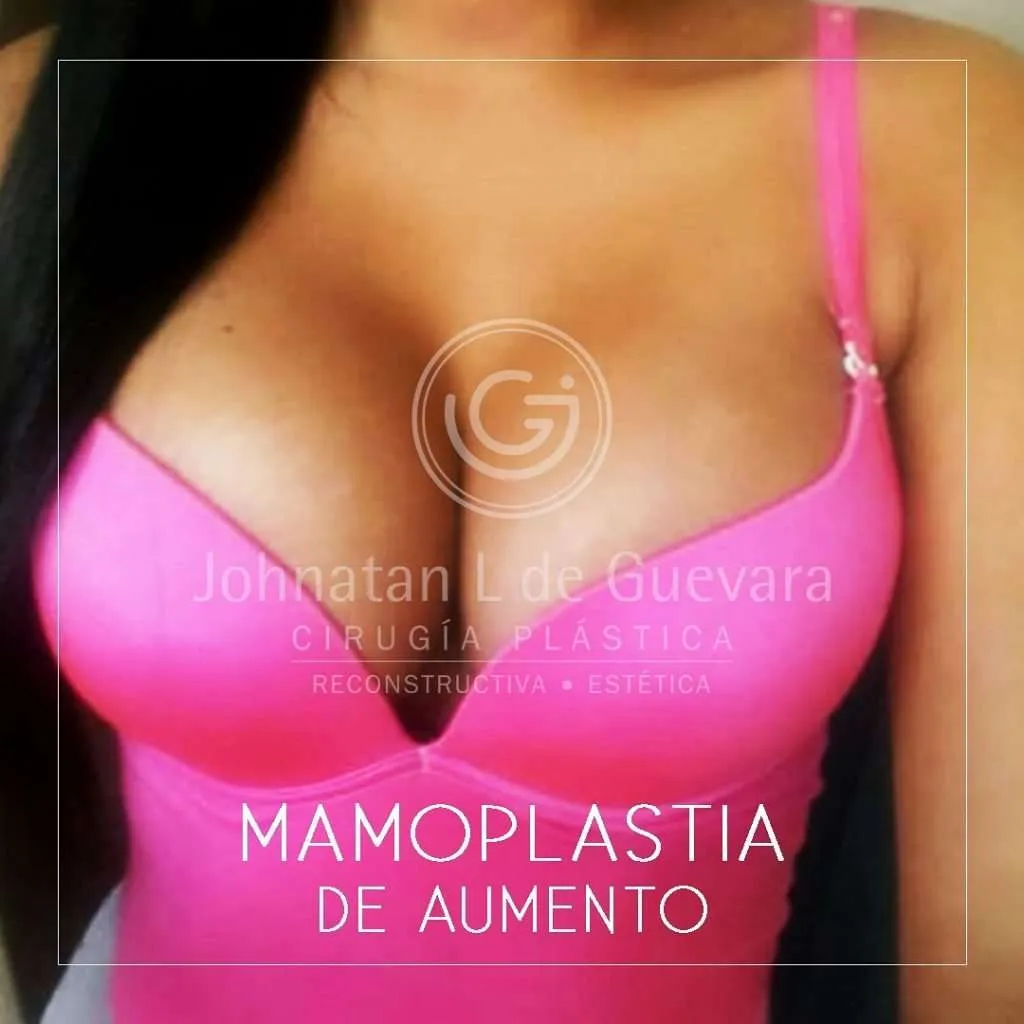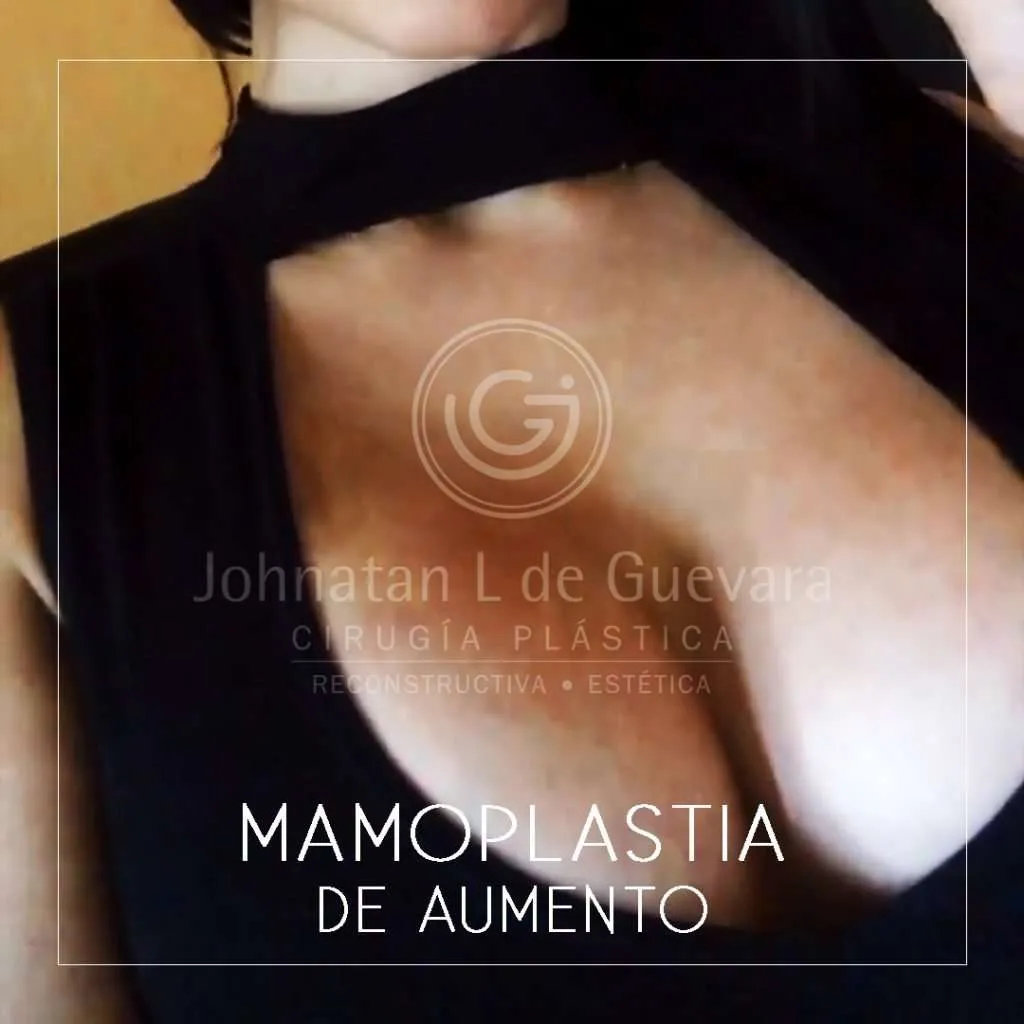Breast Augmentation Bogotá, Colombia

Schedule your appointment for breast augmentation

Dr. Guevara, Plastic Surgeon
What is a breast augmentation?
Breast augmentation is a plastic surgery procedure performed to enhance the size and shape of the breasts. It is the most commonly performed cosmetic surgical procedure worldwide.
Benefits of Breast Augmentation
Confidence and self-esteem
Improves self-perception and confidence in body image.
Natural-looking results
Balanced proportions tailored to the patient's anatomy.
Correction of asymmetry
Helps to equalize the size and shape of the breasts.
Safe procedure
Advanced techniques for lasting and satisfactory results.
Plastic Surgery in Bogotá
Results of Breast Augmentation Surgery
Dr. Guevara ensures the use of the most advanced technology in his plastic surgery procedures, allowing for more precise, safe, and efficient results. His clinic is equipped with state-of-the-art equipment to guarantee the highest quality in every procedure.
¿How is breast augmentation performed?
Breast augmentation is performed under general anesthesia. The surgery typically lasts two to three hours.
There are two main types of breast implants:
Silicone implants: These implants are filled with silicone gel. They are the most commonly used and provide a natural appearance.
Saline implants: These implants are filled with saline solution. They are less commonly used than silicone implants, but they have the advantage of being safer in case of rupture.
The implant is placed either behind the breast gland or behind the pectoral muscle. The placement of the implant depends on the size and shape of the patient’s breasts, as well as their personal preferences.
How does one recover from breast augmentation surgery?
Recovery from breast augmentation is usually quick. Most women can go home on the same day of the surgery. During the first few days after the procedure, it is important to rest and avoid lifting heavy objects. It is also crucial to follow the surgeon’s instructions for wound care.
Most women can resume their normal activities within two to three weeks.
Why would a woman undergo breast augmentation?
There are many reasons why a woman may choose to undergo breast augmentation. Some of the most common reasons include:
- Dissatisfaction with the size and shape of the breasts.
- Loss of volume after weight loss or the breastfeeding period.
- Breast asymmetry in one or both breasts.
Why choose Dr. Guevara?
One of the best plastic surgeons in Colombia at your service.
The numerous positive testimonials from his patients are a true reflection of the satisfaction and trust that Dr. Guevara inspires. His patients highlight his professionalism, dedication, and the exceptional results he has achieved in their lives.
Dr. Guevara is certified by the Colombian Society of Plastic Surgery and the American Society of Plastic Surgeons.

Excelente calificación
A base de 125 reseñasTrustindex verifica que la fuente original de la reseña sea Google. Me realice un procedimiento de otoplastia con el doctor Guevara y todo estuvo perfecto, lo recomiendo mucho para cualquier procedimiento estético.Trustindex verifica que la fuente original de la reseña sea Google. debo decir que tarde en poner una reseña pero espere un tiempo para ver como se comportaba mis protesis, pero el procedimiento fue genial facil, tuve tranquilidad el seguimiento y cabe recalcar que despues de 3 años mis senos estan super bien. tal cual como los desee... elegi un buen cirujano. gracias...Trustindex verifica que la fuente original de la reseña sea Google. Muy buen doctor, excelente, me dejó muy bonita y todo fue muy agradable, aunque al principio estaba bastante nerviosa, se encargaron de brindarme el mejor trato posible, sin pensarlo dos veces volvería a confiar mi cuerpo en las manos del doctor Jonathan GuevaraTrustindex verifica que la fuente original de la reseña sea Google. Recomiendo al Dr Guevara y a todo su equipo de trabajo, estoy más que satisfecha con los resultados, viaje desde Estados Unidos con un tiempo limitado para este procedimiento (lipo, abdominoplastia, lipoinyeccion glútea y aumento de senos) el doctor fue muy profesional y estricto con todos los procesos lo que te hace sentir más segura de que todo se hace correctamente, y agradezco enormemente el seguimiento que me han hecho desde el día 1 hasta el momento, llevo un mes de haberme operado y han estado súper pendientes de mi día a día, desde el primer día que me contacte para realizar la consulta Dayana siempre estuvo dispuesta y muy amable, al igual que María y Valentina que me acompañaron en el post-operatorio son muy profesionales y sobre todo tienen un trato muy humano, los resultados superaron mis expectativas, la mejor decisión haberme operado con el Dr Guevara, gracias!🙏🫶Trustindex verifica que la fuente original de la reseña sea Google. Excelente cirujano, rodeado de los mejores especialistas. Súper recomendado.Trustindex verifica que la fuente original de la reseña sea Google. Tuve una excelente experiencia con el Dr. Guevara durante mi rinoplastia. Desde la primera consulta, su equipo y él me brindaron confianza con su profesionalismo y explicación clara del procedimiento. El día de la cirugía me sentí segura, y la recuperación fue rápida gracias a sus cuidados. El resultado fue natural y superó mis expectativas. Recomendado sin duda alguna!!Trustindex verifica que la fuente original de la reseña sea Google. Vine desde Puerto Rico para hacerme una liposucción y una abdominoplastía. El Dr. Guevara excedió todas mis expectativas. Su trabajo ha sido más que excelente, ha sido impecable. Cuenta él además con excelentes herramientas técnicas para obtener una rápida y eficaz recuperación. Cabe mencionar que el equipo de trabajo del Dr. Guevara es superior, sumamente profesional y humanitario. Muchas gracias a todos y nos vemos pronto.Trustindex verifica que la fuente original de la reseña sea Google. Excelente equipo de trabajo , viaje desde España a operarme con el doctor Guevara , después de 3 meses de la cirugía todo perfecto , no pude estar mejores manosTrustindex verifica que la fuente original de la reseña sea Google. Excelente doctor muy contenta con el procedimiento que me realizo, estuvieron muy pendiente de mi recuperación, lo recomiendo 100%Trustindex verifica que la fuente original de la reseña sea Google. Excelente Dr, estoy Muy contento y agradecido con mi cirugía. ⭐️⭐️⭐️⭐️⭐️
What are the risks of breast augmentation?
Like any surgery, breast augmentation carries certain risks. The most common risks include:
- Hematoma: Blood clotting beneath the skin.
- Infection: Infection in the surgical area.
- Allergic reaction: Allergic reaction to the materials used in the surgery.
- Implant rupture: Rupture of the breast implant.
The risks of serious complications are very low. However, it is important to discuss the risks and benefits of the surgery with the surgeon before making a decision.
The incisions made to place the implant can be:
- Periareolar incision: This incision is made around the areola. It is the most common incision, as it leaves a very discreet scar.
- Inframammary incision: This incision is made in the inframammary fold. It is less visible than the periareolar incision, but it may leave a more noticeable scar.
- Axillary incision: This incision is made in the armpit. It is a very discreet incision, but it is the most difficult to perform.
What are the results of breast augmentation?
The results of breast augmentation are permanent. Breast implants do not move or deteriorate over time. The results of the surgery are highly satisfactory for most women. Women who undergo breast augmentation often feel more confident and attractive.
Is breast augmentation the right option for me?
The decision to undergo breast augmentation is a personal one. It is important to consult with an experienced plastic surgeon to get more information about the surgery and determine if it is the right option for you.
F.A.Q.
Frequently Asked Questions about Breast Augmentation Surgery
Does the placement of implants affect breastfeeding?
The answer is NO, it does not affect breastfeeding.
What size of implants is right for me?
Mis disculpas por el error. Aquí tienes la traducción al inglés:
Once you’ve committed to breast augmentation surgery in Bogotá, you must make another important decision: what size implants are right for you?
The size of the breast implant you choose should reflect your aesthetic goals and lifestyle. Your decision should also take into account long-term considerations such as your health, comfort, and the aging process.
Poorly fitted breast implants produce poor results: accurately measuring the breast implants before surgery will ensure you enjoy the outcome. As a general rule, implants that are too large look unnatural and can lead to risks, causing issues such as back pain, thinning of the tissue around the breasts, and sagging.
So, what factors should guide this very personal choice? There are a number of crucial questions you should consider and discuss with Bogotá-based Plastic Surgeon Dr. Guevara before deciding on the implant size. Some key considerations include:
Do I want a natural look, a slightly enhanced look, or an obviously augmented look?
How will my breast augmentation impact my lifestyle?
How will my implants affect my choice of bras and clothing?
How will my breast implants affect my breast health?
Will my breast implants put me at greater risk of needing a breast lift in the future?
Will the size I choose now make me happy in ten or twenty years?
Consulting with a certified plastic surgeon in Bogotá will help you make the right decision and ensure you get the results you deserve and desire. Breast implants that fit properly and are proportional and balanced for your height and body type are essential for a satisfying outcome.
Initial Considerations: Key Questions to Ask Yourself
Before delving into the more pragmatic aspects of selecting the implant size, such as trying implants or taking measurements, working through some of these preliminary considerations can be very helpful.
What kind of look are you hoping to achieve?
Breast implants are generally divided into two categories: those that look natural and those that do not.
In recent decades, there has been a general shift towards a natural look, helping patients look like a fuller version of themselves. A skilled plastic surgeon can help you achieve fabulous natural results.
One of the most common mistakes women make when committing to breast augmentation surgery in Bogotá is succumbing to the desire for dramatic results, which means getting implants that are too large to look natural.
While many women are excited about the possibility of significantly larger breasts, most are not looking for obviously fake breasts. Dr. Guevara can guide you toward a beautiful, natural-looking bust that doesn’t look fake.
What type of lifestyle do you have?
If you lead an active lifestyle, it’s crucial to understand how implants may affect your regular exercise. The larger the implant, the heavier it will be. Trying on implants by size can help you realize the impact the implant will have on your physical activity.
Larger implants move more during activities like jogging or running.
Will my breasts sag with implants?
It depends on the volume of the implants. The larger the volume, the faster gravity will have its effect. We must remember that aging is a natural process, and obviously, the more weight the breast gland carries, the quicker ptosis (the sagging of the breasts) will occur. That’s why my recommendation is to choose an implant size that is enough to notice the change but not excessive, to avoid breast sagging.
Where are the implants placed?
There are two options: periareolar or inframammary. Usually, the patient can make this decision, but there are certain factors to consider. If the diameter of the areola-nipple complex is less than 3 cm, an implant cannot be placed through the areola-nipple complex (periareolar), and the inframammary route must be used, which means through the breast fold.
What age is it recommended to undergo breast augmentation?
Aquí tienes la traducción al inglés:
The main demographic groups of women who undergo breast augmentation are those between the ages of 25-35. It’s no coincidence that this is also the age when most women have children. After pregnancy, the volume and shape of breast tissue can change. Implants can restore and even enhance the original shape of younger breasts, which is why it remains such a popular procedure among new moms.
Childbirth is not the only reason women undergo breast augmentation. The size and shape of a woman’s breasts can change throughout her life, which is why women in their 40s, 50s, and 60s often choose breast augmentation in combination with other procedures to improve their overall appearance. Breast implants can also correct genetic deformities, severe asymmetry, and extreme underdevelopment in women of any age.
What type of implant is used for breast augmentation?
Medical advances have allowed plastic surgeons to offer more breast augmentation options than before. In addition to the well-known silicone and saline breast implants (both FDA-approved for safety and widely used in augmentation procedures), fat transfer can now also be used to enhance your breasts. In this procedure, the plastic surgeon in Bogotá, Dr. Guevara, performs liposuction in an area with excess fat—typically the waist, abdomen, thighs, back, arms, or buttocks. The fat is processed to remove impurities and then injected into the breast tissue.
Is it true that the nipples hurt during recovery?
During your recovery period, you may experience an increase in nipple sensitivity, which will decrease as you heal. Nipple sensitivity will return to normal levels after a few months. However, nipple sensation is directly related to the size of the implant, as the larger the implant, the more the breast nerves will be displaced to make room. Dr. Guevara will explain nipple sensitivity and the right implant size for you during your first consultation.
What is the recovery time for breast augmentation surgery?
Recovery time varies depending on the patient, but you should see a reduction in pain after a few days and a reduction in swelling after a few weeks. Dr. Guevara will guide you during your consultation on the expected recovery time for your specific case.
What are the risks of breast augmentation?
Any surgical procedure carries a certain degree of risk.
Although most women do not experience complications, some of the possible risks include:
Bleeding: It is possible, although rare, to experience a bleeding episode during or after surgery.
Infection: Infection is uncommon after this type of procedure. If it occurs, treatment may include possible removal of the implant, antibiotics, or additional surgery. It is extremely rare for an infection around the implant to arise from a bacterial infection elsewhere in the body.
Capsular contracture: This generally occurs in less than 10% of patients. The scar tissue that forms around the implant can tighten, causing the implant to become round, firm, and possibly painful. It can occur on one or both sides. The firmness of the breasts may develop soon after surgery or years later.
Treatment for capsular contracture may require surgery, implant replacement, or removal.
Changes in nipple and skin sensitivity: The breasts are usually sore after surgery. It is not uncommon for there to be some changes in nipple sensitivity immediately after surgery. After several months, most patients experience normal sensitivity. Occasionally, partial or total loss of nipple and skin sensation may occur.
Implants: Breast implants, like other medical devices, can fail. Rupture can occur as a result of an injury, during a mammogram, or without any apparent cause. The implant may be damaged during surgery. A damaged or ruptured implant cannot be repaired; broken or deflated implants require replacement or removal. Implants do not last indefinitely and will eventually require replacement surgery. The implants used by Dr. Guevara, Plastic Surgeon in Bogotá, are covered by insurance, which includes new implants in case of rupture or contracture.
Mammography: If you are around 35 years old, it is advisable to have a preoperative mammogram. Breast implants can make mammography more difficult to perform. Implant rupture can occur due to breast compression during the mammogram. You should inform the radiologist of the presence of breast implants so that the appropriate mammographic studies can be performed. Ultrasound, specialized mammography, and MRI may be appropriate to assess breast lumps and the condition of the implants.
Wrinkles and folds in the skin: Folds in the implant may be visible and palpable. It is normal to expect some wrinkling. This may be more pronounced in patients with saline implants or thin breast tissue.
Allergic reactions: In rare cases, local allergies to adhesive tape, sutures, or topical preparations have been reported. Systemic reactions, which are more serious, can occur to medications used during or after surgery. Allergic reactions may require additional treatment.
Anesthesia: Both local and general anesthesia carry risks.










